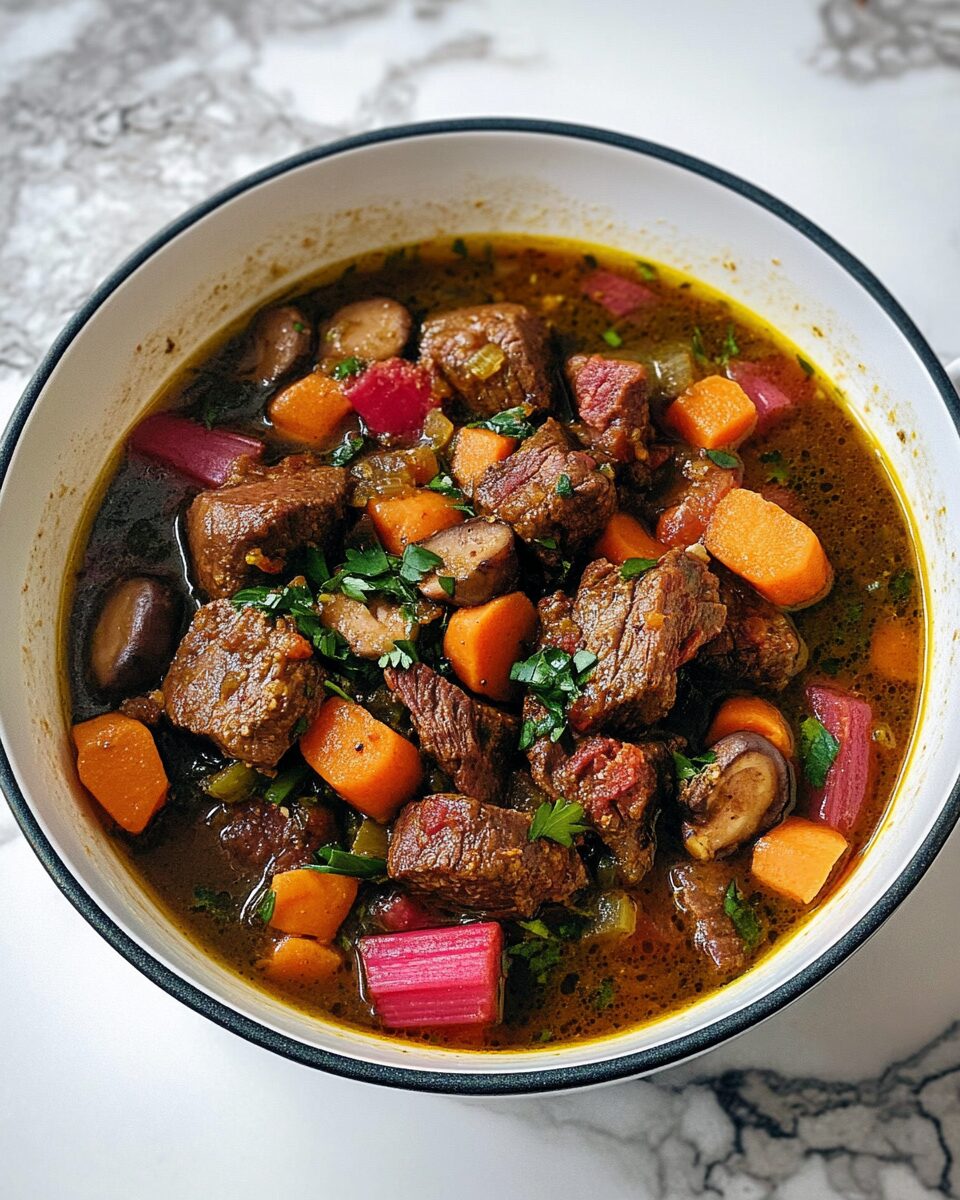Khoresh Rivas is a unique and savory Persian stew that celebrates the often-overlooked versatility of rhubarb. Unlike its usual sweet applications, rhubarb in this dish adds a bright, tangy depth that beautifully complements a rich medley of herbs and tender white beans. Simmered slowly to allow the flavors to meld, this stew offers a comforting yet refreshing profile that makes it perfect for spring and early summer meals. The combination of parsley, scallions, and mint brings a vibrant herbal lift, while turmeric and optional cinnamon hint at Persian culinary tradition. Served with warm rice or flatbread, this plant-based stew is not only wholesome but also surprisingly easy to make. Whether you’re exploring new global flavors or simply trying to use seasonal produce creatively, Khoresh Rivas is a dish worth savoring.
Full Recipe:
Ingredients:
-
2 tablespoons vegetable oil
-
1 medium onion, finely chopped
-
1 teaspoon turmeric
-
Salt and freshly ground black pepper, to taste
-
1 bunch parsley, finely chopped
-
1 bunch mint, finely chopped
-
1 bunch scallions, chopped (white and green parts)
-
2 to 3 stalks rhubarb, cut into 1-inch pieces
-
1 cup cooked white beans (like cannellini or great northern beans)
-
1 tablespoon lemon juice or to taste
-
2 cups water or vegetable broth
-
Optional: 1/2 teaspoon sugar (if rhubarb is too tart)
Directions:
-
Heat the oil in a large pot over medium heat. Add chopped onion and cook until soft and golden, about 5-7 minutes.
-
Stir in turmeric, salt, and pepper. Cook for 1 minute until aromatic.
-
Add chopped parsley, mint, and scallions. Cook for 3-4 minutes, stirring occasionally, until the herbs are wilted and fragrant.
-
Stir in the rhubarb and cook for another 2 minutes.
-
Add the beans, lemon juice, and water or broth. Bring to a gentle simmer.
-
Cover and cook on low for about 25-30 minutes, until the rhubarb is tender but not mushy.
-
Taste and adjust seasoning. Add sugar if needed to balance tartness.
-
Serve warm with steamed rice or flatbread.
Prep Time: 15 minutes | Cooking Time: 30 minutes | Total Time: 45 minutes
Kcal: 185 kcal | Servings: 4 servings
Discovering Khoresh Rivas: A Persian Stew with Soul
Every once in a while, a dish comes along that surprises you not just with flavor, but with emotion, memory, and meaning. Khoresh Rivas, or Persian Rhubarb Stew, is one of those rare gems. On the surface, it may seem like just another stew. But within its simplicity lies a deeply rooted story of tradition, resilience, and the celebration of fleeting seasonal bounty. Made with tart rhubarb, tender white beans, and a medley of fragrant herbs, this dish represents the best of Persian home cooking: soulful, generous, and profoundly comforting.
Let’s dive into the heart of this stew, where culture, seasonality, and nourishment meet in every spoonful.
A Love Letter to Persian Home Cooking
Persian cuisine is a tapestry of aromas, textures, and colors, woven together with history and love. At its core, it’s a cuisine of balance between sour and sweet, soft and crunchy, heat and cool. And in no dish is this harmony more apparent than in the many “khoresh” stews that grace Iranian tables.
Khoresh Rivas, while not as globally known as Khoresh Fesenjan or Ghormeh Sabzi, holds a special place in the hearts of many Iranian families. It’s a seasonal delight, made only in spring and early summer, when fresh rhubarb is at its peak. Because of its short window of availability, it’s considered a fleeting treasure a dish that whispers, “Now is the moment.”
Like many Persian stews, Khoresh Rivas is typically served with fluffy saffron rice or warm flatbread, inviting you to slow down, gather, and savor. The recipe has traveled quietly across generations, often passed from mothers to daughters in handwritten notes and heartfelt demonstrations. Every family makes it a little differently some add lamb, others chickpeas but the soul of the dish always remains the same.
The Unexpected Brilliance of Rhubarb
Rhubarb is often misunderstood. In the West, we know it mostly as a pie filling, sweetened with sugar and paired with strawberries. But in this Persian dish, rhubarb’s natural tartness is celebrated in its unmasked glory. It’s not tamed it’s exalted.
When simmered gently, rhubarb softens into delicate strands that melt into the broth, imparting a bright, lemony tang that electrifies the stew. Unlike citrus or vinegar, its acidity is more floral, more nuanced. It gives the stew a kind of sophisticated sharpness that lingers on the tongue, coaxing you back for more. In Persian culinary philosophy, this kind of sourness known as torshi is highly prized and often central to a dish’s identity.
Here, rhubarb becomes the lead vocalist in a symphony of supporting herbs: parsley, scallions, and mint. Together, they create a layered herbal base that feels like spring itself green, earthy, and fresh.
A Plant-Based Powerhouse That Nourishes the Body
One of the most beautiful aspects of Khoresh Rivas is that it’s naturally plant-based. While traditional versions may include meat, this vegetarian or vegan variation swaps in white beans, and the result is just as satisfying if not more so.
White beans bring not only creaminess and substance but also a powerhouse of nutrition. They’re packed with plant protein, fiber, and complex carbohydrates, making the stew filling yet light. Combined with antioxidant-rich herbs and rhubarb’s vitamins C and K, this dish becomes more than just a comfort food it becomes food that heals.
Especially in today’s world, where many are seeking anti-inflammatory, gut-friendly, and immune-supportive meals, Khoresh Rivas offers an age-old solution. It’s kind to the body, comforting to the soul, and a nourishing way to eat more plants without sacrificing tradition or taste.
The Heartbeat of Seasonal Eating
There’s something deeply grounding about cooking with what’s in season. It reminds us that we’re part of the natural cycle, not above it. Khoresh Rivas connects us to that truth in the most beautiful way.
Rhubarb doesn’t wait for anyone. It appears briefly each spring vivid, tart, and unapologetically unique and then vanishes. You can’t rush it, and you can’t delay it. When it comes, you must be present, ready to honor its moment.
This quality makes Khoresh Rivas not just a meal, but an experience. Cooking it invites us to pause, to notice the changing light, to smell the fresh herbs, and to marvel at how something so simple can feel so special. It’s a dish that teaches us about impermanence and presence, about capturing joy in a bowl.
The Art of Sharing
In Persian culture, food is never just about nourishment it’s about hospitality, connection, and care. Stews like Khoresh Rivas are meant to be shared. They’re the centerpiece of family dinners, holiday feasts, and spontaneous gatherings.
The act of serving this dish often in a large, steaming pot placed at the center of the table is a quiet act of generosity. It says, “You are welcome here. You are cared for.” There’s something inherently loving in the way the flavors are built slowly, with intention, and served abundantly.
Even if you’ve never cooked Persian food before, making Khoresh Rivas allows you to take part in that spirit of giving. It’s a recipe that’s more than its ingredients. It’s an offering.
A Global Flavor with Local Flexibility
Despite its Iranian roots, Khoresh Rivas is incredibly adaptable for modern kitchens worldwide. You don’t need rare spices or expensive tools just fresh rhubarb, good herbs, and a little time. And the beauty of the dish is that it welcomes substitutions.
No white beans? Use chickpeas or lentils. No fresh mint? Try a pinch of dried. Vegetarian today, but craving protein tomorrow? Add tofu or even lamb, if you eat meat. The recipe is forgiving just like any good tradition that evolves with time while staying rooted in its origins.
For home cooks new to Persian cuisine, Khoresh Rivas is a gentle entry point. It doesn’t rely on complicated techniques, and yet it opens a door to a world of flavor you might not have known was missing.
Conclusion:
Khoresh Rivas is not just a springtime stew it’s a celebration of seasonality, a meditation on sourness, and a hug from Persian kitchens past and present. It reminds us that food can be bold without being overwhelming, nourishing without being heavy, and simple without being boring.
More than anything, this dish invites us to cook with heart. To look at familiar ingredients like rhubarb in unfamiliar ways. To explore cultures through the warmth of their kitchens. And to slow down long enough to appreciate how powerful a single bowl of food can be.

